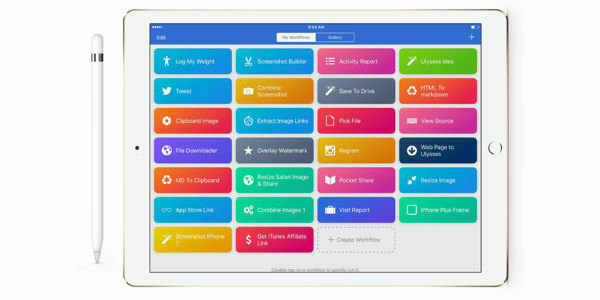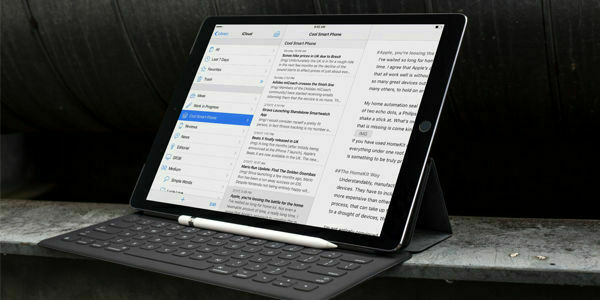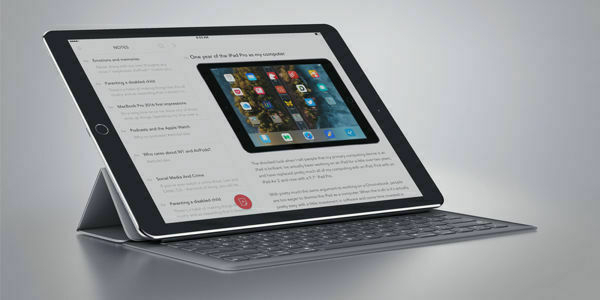The shocked look when I tell people that my primary computing device is an iPad is brilliant. I’ve actually been working on an iPad for a little over two years, and have replaced pretty much all of my computing with an iPad. First with an iPad Air 2 and now with a 9.7” iPad Pro.
With pretty much the same argument to working on a Chromebook, people are too eager to dismiss the iPad as a computer. When the truth is it’s actually pretty easy. With a little investment in software and some time invested in setting things up the way that suits you best. You can do. Out of your daily tasks with little thought, but dig in deep and you can do 99% of your requirements on one device.
Quite a few of my friends have adopted the same approach now the iPad has a great keyboard case, and use it as I do. Unfortunately most people don’t want to put in the time and are often dismissive, however I really think more people should embrace the iPad as a computer.
Apps to do anything
Let’s be honest, as great as iOS10 is there are still holes in Apples OS. Thankfully most of these are filled by the rich app ecosystem. I have spent far too much money on apps over the years, and unfortunately most of the expense has been on apps that I no longer use. Reviewing the use case of new apps, trying things out and experimenting. Only for it ultimately to fall short in some area, not meet my needs or very often become superseded by something better.
I never have many apps on my iPad, but what I do have installed are used often. I made the mistake very early on of carrying around a replica of my iPhone on a bigger scale, but quickly realised there is no need. Both devices have completely different uses and should be treated as such. Don’t flood your iPad with social and communication apps unless you intend to use them often.
With that all said there are a few apps I can’t do without:
- Workflow
- Ulysses
- Notes – now replace by Bear
- Documents
- Medium
- Notability
- Day One
- Linky
These apps are the ones used daily, when writing or reading. I have a lot of media apps for watching movies or TV shows at the gym or while traveling, but your use case will vary. I will not go into extensive details about everything I use, but give you a shallow overview, if you want to dig in deep check out MacStories second update on using an iPad Pro.
Automation
This is where almost everyone I speak to falls off and sticks to more traditional means. Maybe it’s because things are easier, maybe it’s muscle memory, maybe there isn’t a real reason, but users fall by the wayside quite early. However with a little work and research you can pretty much achieve anything you need from a computer and often make it much more straight forward.

Workflow
Workflow is not complicated nor confusing it just takes a little time investment and reading to get the hang of it. I’ve been using the app for more than a year and it is the best app I have ever bought, it is the cornerstone of much of my productivity.
Think of Workflow as Automator for iOS, plugging into countless (but not every) app and making things much easier. It works by creating recipes by dropping actions together. You can then feed information into the recipe, ‘run’ them and get your desired outcome.
I have invested time in making Workflow recipes or finding them in other people’s blogs and making them my own. They do all sorts of things for me, from resizing images for publishing to wrapping my screenshots in device frames and stitching images together.
My most used of which isn’t my own work but I have modified it slightly for use on my blog. Jordan Merrill created a screenshot builder for you to easily import into your own set up, the full guide is easy to follow and can be found here. You can also achieve a similar result using the app LongScreen, select your screenshot and tap the magic wand at the bottom.
I also use several workflows for resizing images for my featured image sizes and also combining my device images together. However these are only a small selection of workflows that I use, over the last year or so I have built up an armoury of resources. Allowing me to adapt or create recipes for many of my daily tasks.
There would be no point sharing many of these as they would be unique to my image sizes etc, but they are pretty easy to create with a few minutes digging in. If you are serious about using Workflow there is no better resource than the Club MacStories newsletter, for the small subscription you get access to all of the content created from which there are hundreds of ideas.
Notes, words and writing
The title of this post started of as “running my blog from an iPad” because that is exactly what I do. I spend most of my time writing on my iPad or digesting what I am about to write. I have used many apps over the years, starting on Google Docs, graduating to the markdown editor Byword. I now use the amazing if a little expensive Ulysses app.

Ulysses
There must already be millions of words already written about Ulysses, it is considered the pro wiring app on Mac and only relatively recently came across to iOS. I resisted for a long time purely down to price, and the fact that at the time Byword was a perfectly good Markdown editor. Yet the move was smooth and a very rewarding one.
The deciding factor was publishing. Ulysses allows me to see exactly how an article will look before publishing. Although publishing to WordPress is available from a few different apps, compatibility and preview where always not quite right. Meaning I had to use the a webpage or god forbid the awful WordPress app to correct things. Whereas I can input local images into a document and they will be uploaded along with all of the text.
Organisation and syncing in Ulysses is also second to none, allowing for articles written on any device I own, syncing to all and organised exactly as I wish. Most other Markdown apps use an iCloud folder sync that can be slow and very unreliable. Not to mention that dumping all of the files in one folder means trying to find an old file can be a nightmare.

Bear
The regular old stock Notes app that has been my place to store everything has recently been replaced with Bear. By calling Bear a notes app it is much more approachable. When in reality it is a Markdown editor at heart. Allowing you to add in formatting while typing, for sharing later or simply for your own use. With a couple of key strokes you can add in links, headings, tick boxes, and even images.
Bear has been expertly designed in both aesthetics and function. All of your notes are listed on the left hand menu, which can be accessed with a right swipe. Once you are editing or looking at a note the developers have made all of the formation options available in a shortcut bar above the keyboard. This sounds a simple thing to do, but lots of others hide these away behind a formatting menu.
I have slotted Bear in between my current writing app of choice, Ulysses, and my brain. It gives me the ability to format and position text in a small light weight app before moving them to Ulysses for images and publishing.
I also use Notability quite often for hand written notes, these are usually more work related than writing but there is something really great about hand writing notes. The Apple Pencil also allows me to jot down things if the mood strikes me, although I have found myself not using these as often as I expected. Should the new iPad Pro be launched with a new Apple Pencil I will think twice about punching it as this just isn’t what I have used my iPad for, although many people use it daily.
Documents app as a document picker
The cry from those dismissive of a productive iOS user is that you can’t do anything without a file system. Unfortunately in the past this may have been true, but since iOS 8 users have been able to do much more and very easily. The introduction of iCloud Drive with iOS 10 is the closest users have come to a file system, and is already proving to be really useful.
Not only because syncing of documents is much easier, with far more file types supported. With this has come syncing from a mac computer of all users documents into ‘the cloud’. Meaning working from anywhere is possible, whatever you are doing there is a wealth of apps out there to help.
With that said the major upside to making the ‘drive’ part of iCloud more accessible has been allowing apps to use the storage area to manage files much better. Documents by Readle is an essential app for users wanting to work with specific files and be productive.
 This plugs in perfectly with PDF expert, which is an essential if you work with PDF like I do. I can open, read, edit or sign documents and email them back. Whereas in the past I would have to print off pages, to then scan them back onto a file again.
This plugs in perfectly with PDF expert, which is an essential if you work with PDF like I do. I can open, read, edit or sign documents and email them back. Whereas in the past I would have to print off pages, to then scan them back onto a file again.
If you don’t want to use iCloud, or you have to use storage elsewhere then Documents can grab documents from Dropbox, Google drive, Box, One Drive and almost everywhere else including an FTP server. The design could do with an update, but it is functional and works perfectly – which is exactly what’s needed.
Documents can manage almost any file type, allowing users to open, edit and send them inside the app. It even allows you to download and extract zip archives from web links using an internal browser. File management is still not desktop class, but I would argue that it really doesn’t need to be. Ask yourself what you actually need to do with the files on your desktop or laptop and I would say 70% of that can be done on iOS.
Medium and reading
I’ve been publishing everything for the past year or so to Medium. My personal blog, tech stuff and also posts that I’ve started writing about my daughter and her life with a disability. When I first decided to do this, Medium was fresh and new, with a growing reputation of the place to be. I loved that they had control about how things looked, not only because I didn’t have to work maintaining and managing a theme for the site, but also because everything looked the same.
It was a place I went to read things, and so did many many other people. Open the app and there was a wealth of available content that was relevant to what you like. Medium expanded my reach to people that had no idea about my website, but perhaps read the same sort of things as I produce. I let their trusty algorithm serve up my posts to people it felt would read it. A win on all sides whichever way you looked at it.
Even though this has changed over the last few months there is still lots of interesting articles that people publish to the platform, it is a staple app for digesting content. The iPad app is also a really nice writing app to publish from, even though I use Ulysses the Medium app stands up pretty well it terms of usage.

Journaling on Day one
For the last couple of years I have gone backwards and forwards with journaling, both in the digital and physical sense. I am no longer writing in here, although it is a great app if you want to write and even publish a blog from here. My usage is as a scrap book to store links to everything I write and pictures I post.
Along with IFTTT recipes I have stored everything I post for every website I write for, and also Instagram photos. As I produce more and more content on the digital web Day One keeps a record of all this, dated and linked for me to look back on.
Pocketing things to read later
The reason my iPad is so useful to me is because I can fold it out into a writing device with keyboard and tap away until my hearts content. I can do this for hours with great battery life and then simply fold it up and slip it into a small sleeve in my bag. Yet the greatest thing is pulling the keyboard off and just relaxing, reading a book or more often than not catching up on my reading list in Pocket .
 I have gone backwards and forward with read it later services over the last few weeks, but in reality there is only two to be considered. Pocket or Instapaper, it is that simple. I recently switched away to Instapaper, and even wrote a guide on how to do it easily, but after some issues with Instapaper syncing I’m back using Pocket. The social sharing and also the recommended articles are a great service where you can discover things that may have slipped you by.
I have gone backwards and forward with read it later services over the last few weeks, but in reality there is only two to be considered. Pocket or Instapaper, it is that simple. I recently switched away to Instapaper, and even wrote a guide on how to do it easily, but after some issues with Instapaper syncing I’m back using Pocket. The social sharing and also the recommended articles are a great service where you can discover things that may have slipped you by.
Setting this up with IFTTT recipes for sharing is dead easy, and you can even follow your social media friends to see what they are recommending and widen your reading circle.
Sharing with Linky
I discovered Linky completely by chance whilst looking for something to share links on a business twitter account I manage. This simple app is one of the most straight forward but yet the most confusing if you dive straight in. In broad terms it is a share sheet app that allows easy sharing of information to multiple accounts on social mediate in recent updates it has gained lots more features.
When opening the app you are greeted with nothing but a browser, yet its real power comes from the share sheet. This is indispensable to me for sharing to more than one twitter account, but also for clearing Apple News links! This caught me out several times when sharing interesting articles, meaning people on other platforms cannot read them, nor can people that have removed the app.
When sharing from inside Apple News Linky will find the regular link and share that instead.

Can’t Do’s
Unfortunately the iPad just cant do everything, there are some things that a desktop type browser is essential and no amount of mediating with Documents will work. This ranges from simple things such as options and menus not appearing on mobile safari version of web pages. Right the way through to recording audio whilst taking part in a podcast.
These types of things crop up in the most annoying places, such as my resent adventure moving from Pocket to Instapaper. There are also gaps in the armoury that is provided by the App Store to. For example the desktop version of Garadgeband is a great app for editing podcast audio, yet the iPad app doesn’t even entertain the idea.
There is still no option for these few very important use case of mine. So sitting in front of a Mac is still unavoidable for some tasks. Although these issues are decreasing more and more over time. Using an iPad is less about computing power and more about versatility. Perhaps this is the reason many Windows laptop have taken the convertible route? I am more than certain we will never see a convertible macOS device, but we already have a brilliant iOS one.
Using an iPad
As more and more people realise that much of what they need to do on a ‘computer’ can be done on less traditional hardware the world changes. The frustration is users being put off by media commentary before they have ever tried using one, the same headlines written by tech blogs are regurgitated by end users. I see the same people argue that you can’t work on an iPad are many of the same supporting the use of a Chromebook.
I would challenge everyone to find many use cases where you can’t use an iPad for most of your computing tasks. The iPad offers unrivalled battery life for usage whilst traveling, combined with something that is lighter than any laptop available.
The OS and extensive suite of apps in many ways are more capable and straight forward than a desktop OS. If you want to make the most of using your iPad as a computer, it doesn’t have to be an iPad Pro at all. Yet you will need to spend a bit of time deciding what you want to use it for, and open your mind to the possibility.